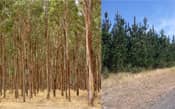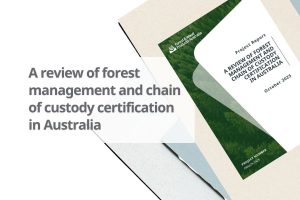Predicted changes to Australia’s climate over the next one to three decades will affect management strategies for Australia’s Eucalyptus globulus and Pinus radiata plantations. Forecast changes in the frequency and intensity of droughts, bushfires, and emergent diseases and pests will affect where plantation managers can plant with the confidence of getting a healthy tree crop and how they should look after their trees.
Researchers from CSIRO Land and Water Flagship, with support from FWPA, have spent three years modeling predictions of plantation productivity for 2030 and 2050 under a range of likely climate scenarios. They examined data from a variety of sites in five key Australian forestry regions: southern Western Australia; the Green Triangle in South Australia and Victoria; Eastern Victoria and southern New South Wales; and northern New South Wales.
As a result, the Australian plantation industry now has a greatly improved capacity to quantify and manage both the risk and impact associated with climate change and variability, from the scale of a region down to a site.
The project developed a series of regional reports to assist industry understand and mitigate potential future hazards. Five climate scenarios were used for the analyses, and the results refined to deliver management practices that may improve survival and growth no matter which climate pattern will ultimately occur. Thus identifying future opportunities for growers.
Working closely with growers the researchers were able to use historical plantation management and silviculture data. The researchers used three models to look at climate risks and impacts: CABALA—CSIRO’s plantation growth and water use model for analysis of productivity and the impacts of drought on stand mortality; e-Cambium, which uses information about site, management regime and daily weather data to predict variation in wood density and stiffness; and Climex, which predicts changes in the distribution and abundance of invasive insect pests related to climate.
The research looked at how wood properties might alter with climate change. Increased temperature, reduced water availability and elevated CO2 levels generally tend to increase wood density, although the effects of CO2 are small relative to effects of temperature and water availability. It also considered the likelihood and impacts of increased drought, pests and fire, as well as whether current growing and management practices can adapt to cope or whether new production systems (e.g. new species, new products) may be required.
The results indicate that for E. globulus, lower stocking rates in water limited environments can substantially reduce the risk of mortality without reducing productivity. Applying fertilizer may increase productivity to current levels but possibly may increase risk of tree mortality. For P. radiata, modeling suggests that increasing the initial stocking or reducing the number of thinning’s to two and delaying the first thinning will increase productivity but the effect on risk is unclear.
Importantly this tool will better enable growers, at both the regional and sites specific levels, to manage risk and identify future opportunities in both soft and hardwood plantation estates.
View project report here
View webinar presentations here




